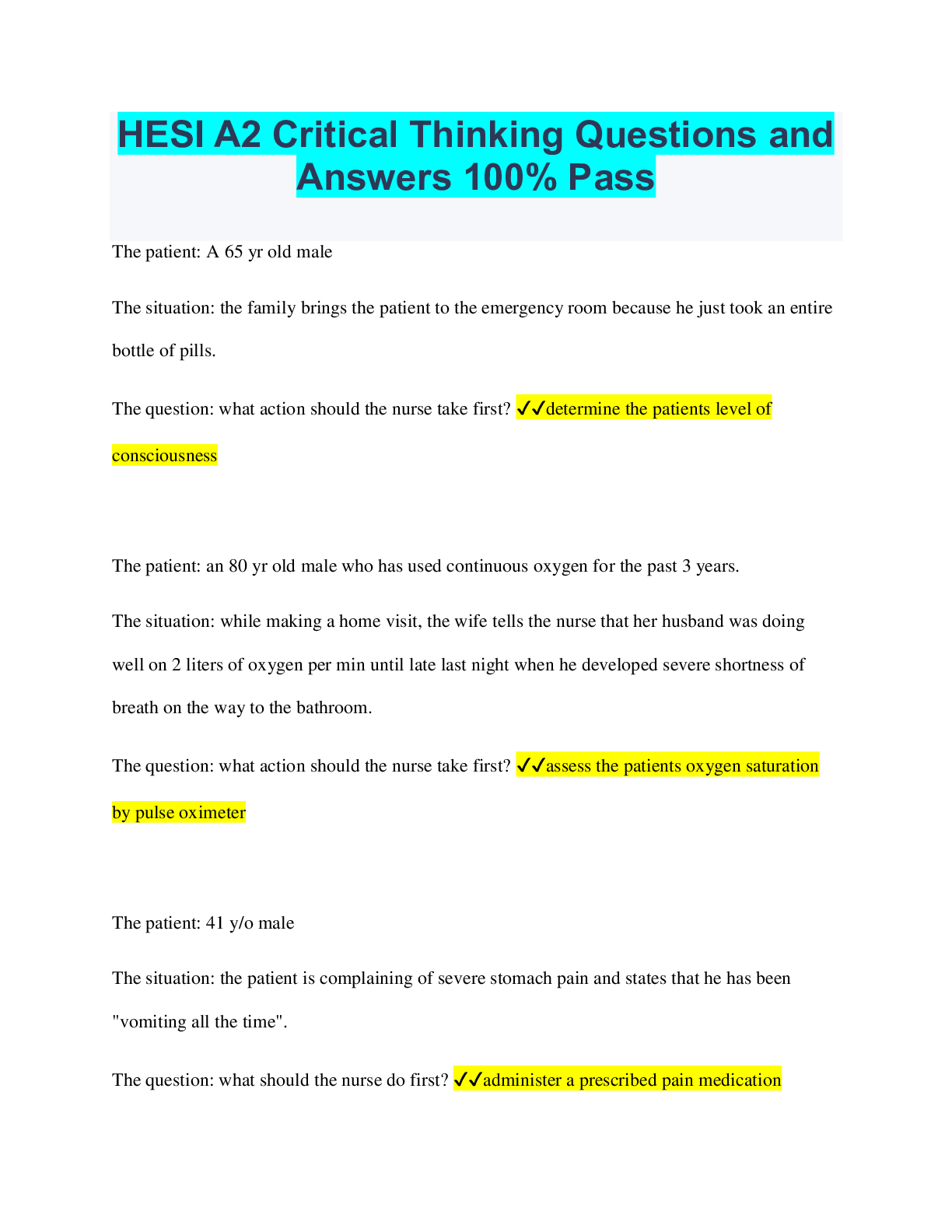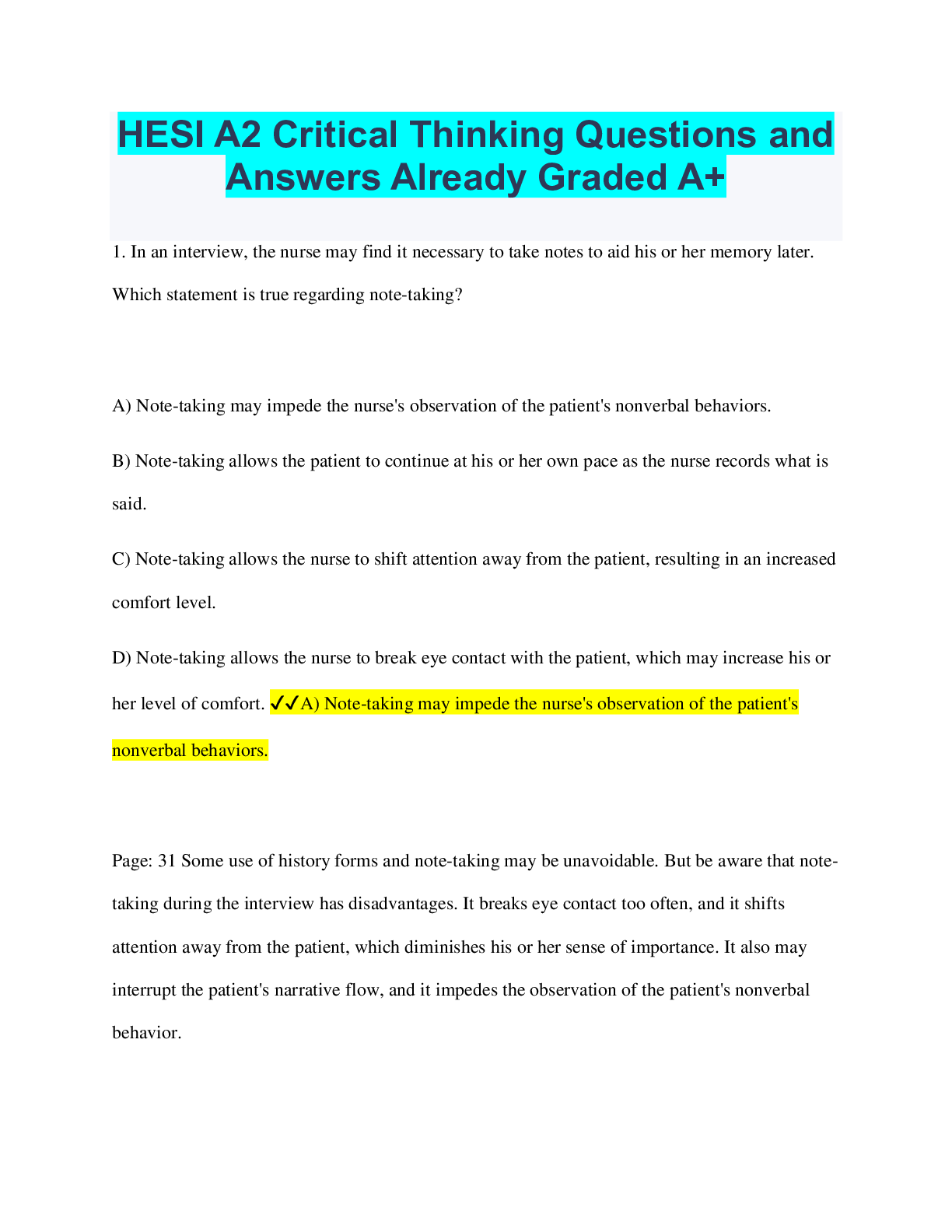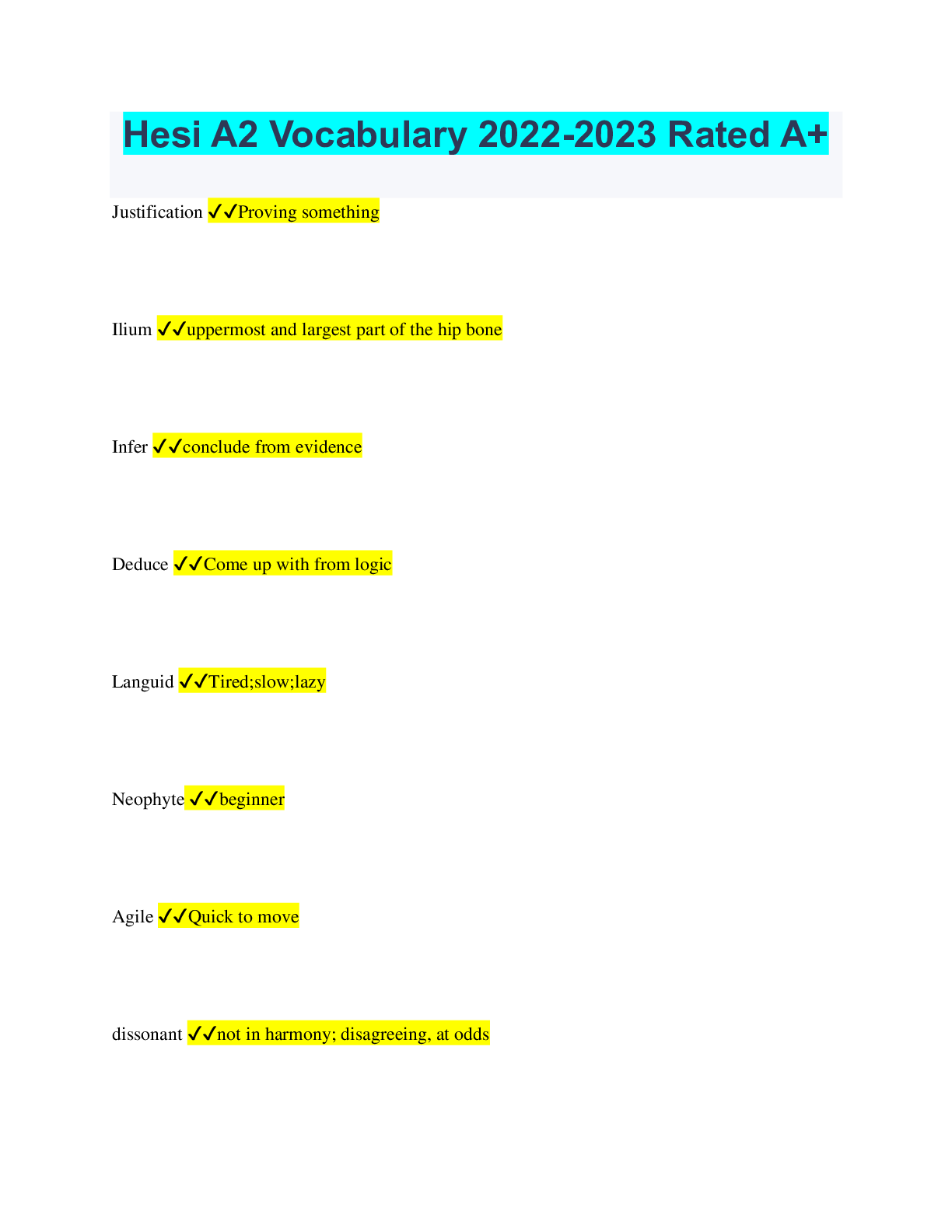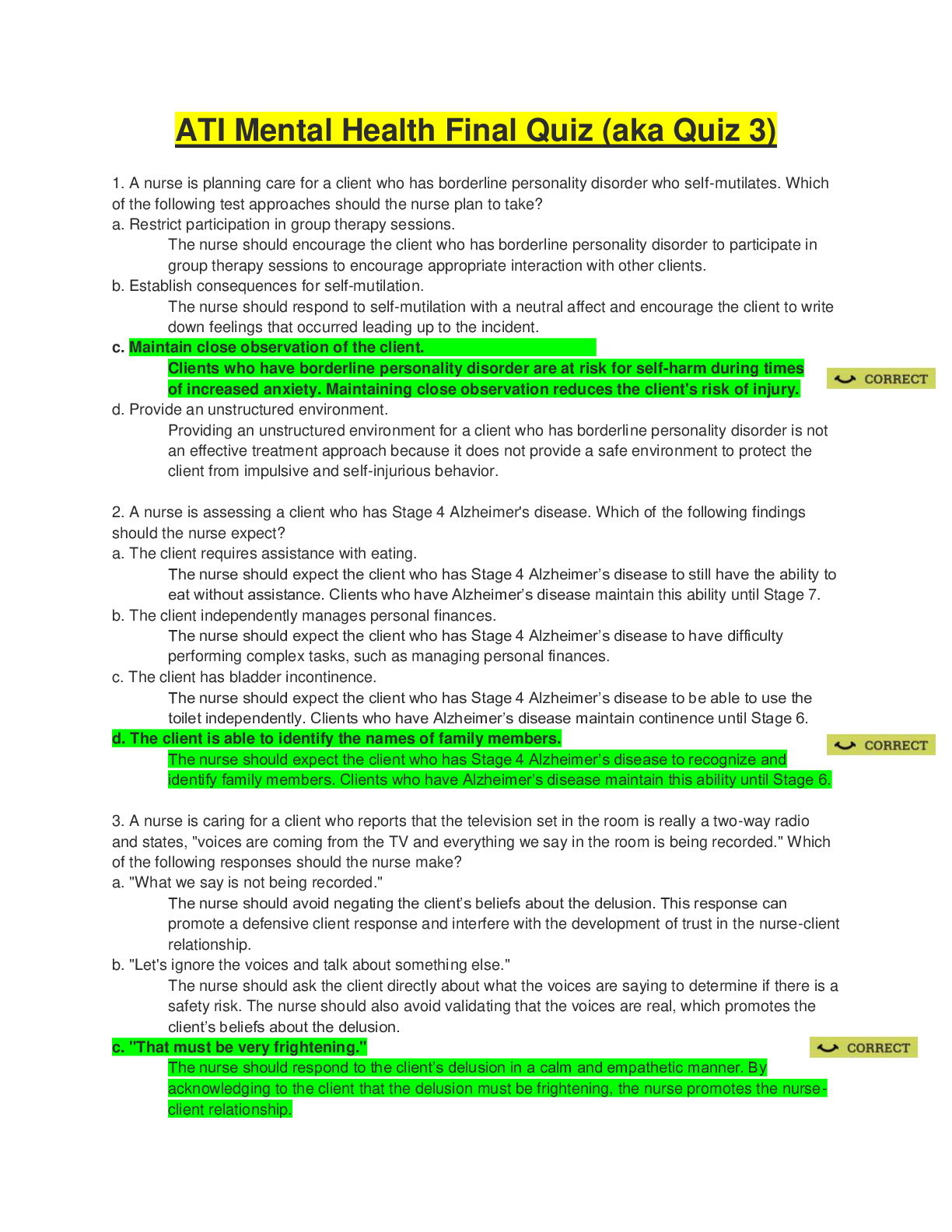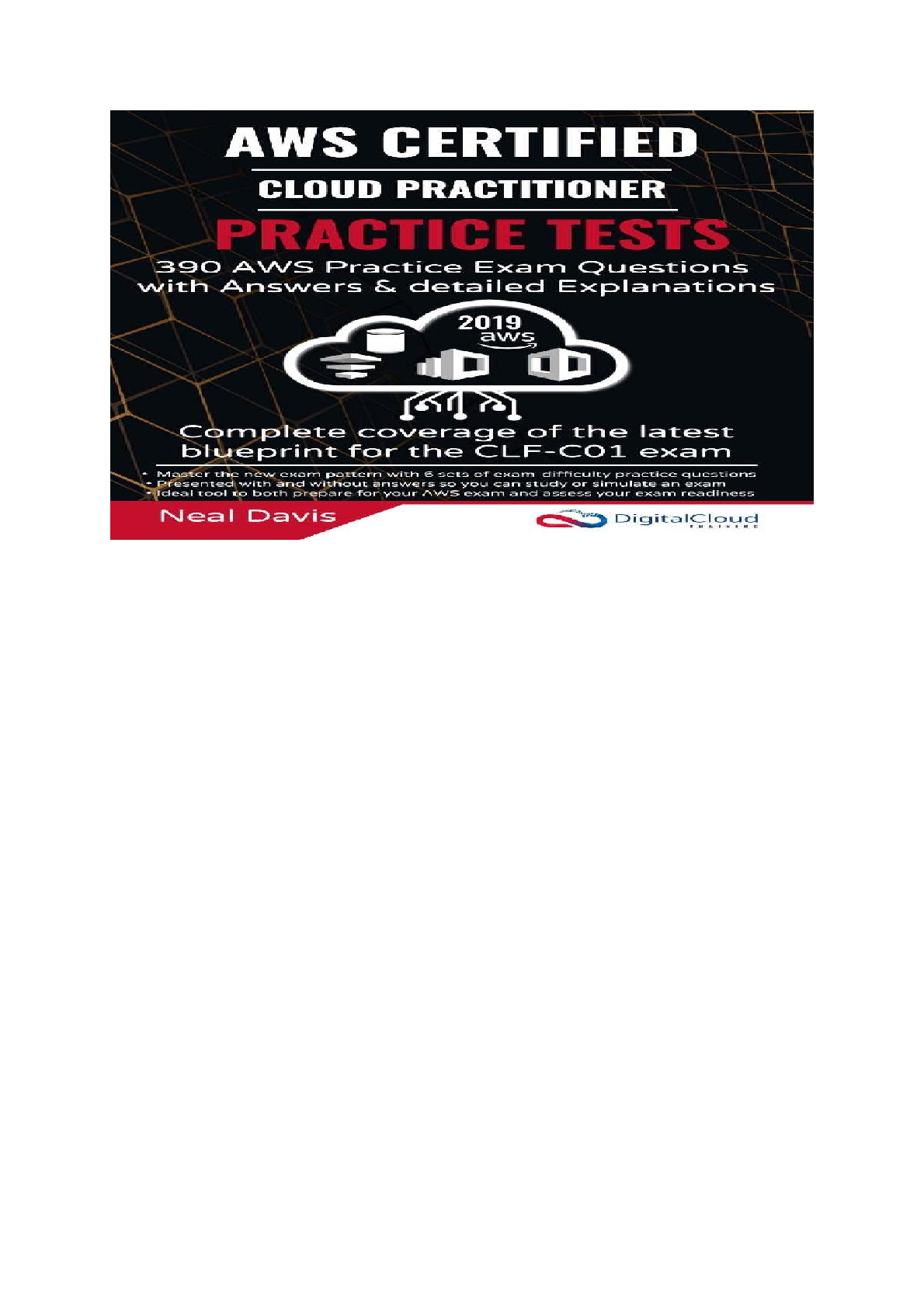*NURSING > QUESTIONS & ANSWERS > NURSING NR 326 : Mental Health Final Quiz (aka Quiz 3) With Answers & Explanations, Latest 2020/2021 (All)
NURSING NR 326 : Mental Health Final Quiz (aka Quiz 3) With Answers & Explanations, Latest 2020/2021.
Document Content and Description Below
Mental Health Final Quiz (aka Quiz 3) 1. A nurse is planning care for a client who has borderline personality disorder who self-mutilates. Which of the following test approaches should the nurse pla... n to take? a. Restrict participation in group therapy sessions. The nurse should encourage the client who has borderline personality disorder to participate in group therapy sessions to encourage appropriate interaction with other clients. b. Establish consequences for self-mutilation. The nurse should respond to self-mutilation with a neutral affect and encourage the client to write down feelings that occurred leading up to the incident. c. Maintain close observation of the client. Clients who have borderline personality disorder are at risk for self-harm during times of increased anxiety. Maintaining close observation reduces the client's risk of injury. d. Provide an unstructured environment. Providing an unstructured environment for a client who has borderline personality disorder is not an effective treatment approach because it does not provide a safe environment to protect the client from impulsive and self-injurious behavior. 2. A nurse is assessing a client who has Stage 4 Alzheimer's disease. Which of the following findings should the nurse expect? a. The client requires assistance with eating. The nurse should expect the client who has Stage 4 Alzheimer’s disease to still have the ability to eat without assistance. Clients who have Alzheimer’s disease maintain this ability until Stage 7. b. The client independently manages personal finances. The nurse should expect the client who has Stage 4 Alzheimer’s disease to have difficulty performing complex tasks, such as managing personal finances. c. The client has bladder incontinence. The nurse should expect the client who has Stage 4 Alzheimer’s disease to be able to use the toilet independently. Clients who have Alzheimer’s disease maintain continence until Stage 6. d. The client is able to identify the names of family members. The nurse should expect the client who has Stage 4 Alzheimer’s disease to recognize and identify family members. Clients who have Alzheimer’s disease maintain this ability until Stage 6. 3. A nurse is caring for a client who reports that the television set in the room is really a two-way radio and states, "voices are coming from the TV and everything we say in the room is being recorded." Which of the following responses should the nurse make? a. "What we say is not being recorded." The nurse should avoid negating the client’s beliefs about the delusion. This response can promote a defensive client response and interfere with the development of trust in the nurse-client relationship. b. "Let's ignore the voices and talk about something else." The nurse should ask the client directly about what the voices are saying to determine if there is a safety risk. The nurse should also avoid validating that the voices are real, which promotes the client’s beliefs about the delusion. c. "That must be very frightening." The nurse should respond to the client’s delusion in a calm and empathetic manner. By acknowledging to the client that the delusion must be frightening, the nurse promotes the nurse- client relationship. d. "Why do you think the TV is a two-way radio?" The nurse should avoid asking the client a "why" question, which promotes a defensive client response. 4. A nurse is planning care for a newly admitted client who has bipolar disorder and is experiencing acute mania. Which of the following client goals should the nurse identify as the priority? a. Practicing problem-solving skills The nurse should encourage the client to practice problem-solving skills during the continuation phase of treatment; however, there is another intervention that is the priority during the acute phase of bipolar disorder. b. Understanding of medication regimen The nurse should ensure that the client understands the medication regimen during the continuation phase of treatment; however, there is another intervention that is the priority during the acute phase of bipolar disorder. c. Identifying indications of relapse The nurse should teach the client to recognize indications of relapse during the continuation phase of treatment; however, there is another intervention that is the priority during the acute phase of bipolar disorder. d. Maintaining adequate hydration The nurse should identify that the priority goal is to prevent physical exhaustion, maintain health, and meet nutritional and rest needs during the acute phase of the client’s manic episode. The nurse should consider Maslow’s hierarchy of needs, which includes five levels of priority when planning care for this client. The first level consists of physiological needs; the second level consists of safety and security needs; the third level consists of love and belonging needs; the fourth level consists of personal achievement and self-esteem needs; and the fifth level consists of achieving full potential and the ability to problem solve and cope with life situations. When applying Maslow’s hierarchy of needs priority-setting framework the nurse should review physiological needs first. The nurse should then address the client’s needs by following the remaining four hierarchical levels. It is important, however, for the nurse to consider all contributing client factors, as higher levels of the pyramid can compete with those at the lower levels, depending on the specific client situation. The fourth level of Maslow’s hierarchy of needs includes usefulness, self-worth, and self-confidence in fulfilling self-esteem needs. 5. A nurse is preparing to administer benzodiazepine to a client with Generalized Anxiety Disorder. The nurse should tell the client to expect with of the following adverse reactions? a. Tinnitus Tinnitus is not an adverse effect of benzodiazepines. b. Bradycardia Tachycardia, rather than bradycardia, is a potential adverse effect of benzodiazepines. c. Halitosis Halitosis is not an adverse effect of benzodiazepines. d. Sedation The nurse should tell the client to expect sedation as an adverse effect of benzodiazepines because of the CNS depression effects. 6. A nurse in a mental health unit is planning care for a client who is receiving treatment for self-inflicted injuries. The nurse should identify which of the following interventions as the priority when planning care for this client? a. Promoting and maintaining client safety The nurse should recognize that the client who has self-inflicted injuries is at risk for further self-harm or suicide; therefore, the client’s safety is the priority. The nurse should apply the safety and risk reduction priority-setting framework when planning care for this client. This framework assigns priority to the factor or situation posing the greatest safety risk to the client. When there are several risks to client safety, the one posing the greatest threat is the highest priority. The nurse should use Maslow’s hierarchy of needs, the ABC priority-setting framework, or nursing knowledge to identify which risk poses the greatest threat to the client. b. Discussing reasons for the client's behavior The nurse should communicate with the client to discuss reasons for the client’s behavior; however, there is another action that is the priority. c. Assisting the client to recognize feelings The nurse should assist the client to recognize feelings; however, there is another action that is the priority. d. Teaching the client alternative coping strategies The nurse should teach the client alternative coping strategies; however, there is another action that is the priority. 7. A nurse is providing teaching to a client who has a new prescription for disulfiram for management of alcohol dependence. Which of the following dietary choices should the nurse instruct the client to avoid? a. Peppermint candy It is not necessary for the client to avoid peppermint while taking disulfiram. b. Pure vanilla extract The nurse should instruct the client to avoid alcohol and alcohol-containing substances, such as pure vanilla extract, while taking disulfiram. The ingestion of alcohol while taking this medication causes a disulfiram-alcohol reaction, which is manifested by hyperventilation, dizziness, vomiting, and hypotension. c. Salt Though certain medications require a reduction in sodium intake, it is not necessary for the client to avoid salt while taking disulfiram. d. Chocolate Though certain medications require a reduction in caffeine-containing substances such as chocolate, it is not necessary for the client to avoid chocolate while taking disulfiram. 8. A nurse is planning care for a client with a physical dependence of Alprazolam and must discontinue the medication. Which of the following should the nurse include in the plan? a. Taper the medication gradually over several weeks. The nurse should plan to taper the dosage of alprazolam gradually over several weeks, possibly months. This gradual reduction in dosage reduces the manifestations of withdrawal. b. Encourage participation in stimulating physical activity. The nurse should provide the client with a calm, low-stimulation environment to decrease the anxiety and physical manifestations that can result from alprazolam withdrawal. c. Monitor the client for a return of anxiety for up to 72 hr following discontinuation of the medication. The nurse should plan to monitor the client for at least 3 weeks following discontinuation of the medication for a return of anxiety manifestations. d. Implement restraints and seclusion as needed. It is not necessary to restrain or seclude the client during withdrawal from alprazolam. Restraints are considered restrictive, and the nurse should work to promote the least restrictive environment. 9. A nurse is caring for a newly admitted client who is receiving treatment for alcohol use disorder. the client tells the nurse “I have not had a drink for 6 hours.” Which findings should the nurse expect during alcohol withdrawals. a. Low body temperature The nurse should expect the client who is experiencing alcohol withdrawal to have an elevated temperature. b. Insomnia The nurse should expect the client who is experiencing alcohol withdrawal to have insomnia and restlessness. c. Muscle flaccidity The nurse should expect the client who is experiencing alcohol withdrawal to have muscle tremors. d. Bradycardia The nurse should expect the client who is experiencing alcohol withdrawal to have tachycardia. 10. A nurse is caring for a client who is receiving treatment for alcohol detoxification. Which of the following medications should the nurse expect to administer during this phase of the client's care? a. Buprenorphine The nurse should expect to administer buprenorphine to a client during opiate detoxification. b. Diazepam The nurse should expect to administer diazepam to a client during alcohol detoxification. Anti-anxiety agents, such as chlordiazepoxide and diazepam, are long-acting CNS depressants that are used to minimize the manifestations of alcohol withdrawal. c. Varenicline The nurse should expect to administer varenicline to a client who has nicotine use disorder. d. Rimonabant The nurse should expect to administer rimonabant to a client who has nicotine use disorder. 11. A nurse is speaking to a community group about the diagnosis and treatment of clients who have Alzheimer's. The nurse should conclude that the members of the group need further teaching when she identifies the following as manifestations of Alzheimer Disease. a. Impaired judgment The nurse should identify impaired judgment as a common manifestation associated with Alzheimer Disease. b. Sudden confusion The nurse should clarify that the client who has Alzheimer’s disease is expected to exhibit confusion that develops slowly over a period of months. Clients who have delirium exhibit sudden confusion. c. Personality change The nurse should identify that clients who have Alzheimer’s disease are expected to exhibit changes in personality as the disease progresses. d. Remote memory loss The nurse should identify recent and remote memory loss as common manifestations associated with Alzheimer’s disease. 12. A nurse is providing teaching to a client with Generalized Anxiety Disorder and a new prescription for Buspirone. The nurse should inform the client that which of the following manifestations is a common adverse effect of this medication? a. Confusion Confusion is not an adverse effect of buspirone, though the client might experience decreased concentration and headache. b. Bradycardia Tachycardia and palpitations, not bradycardia, are possible adverse effects of buspirone. c. Dizziness The nurse should inform the client that dizziness is a common adverse effect of buspirone. The nurse should instruct the client to avoid driving and operating heavy machinery until the presence of adverse effects is determined. d. Insomnia Drowsiness, not insomnia, is an adverse effect of buspirone. 13. A nurse is reviewing the medications of a client who has bipolar disorder and a new prescription for lithium. The nurse should identify that it is safe to administer which of the following medications while the client is taking lithium? a. Ibuprofen Ibuprofen is not safe to administer to a client who is taking lithium because it can cause increased kidney absorption of lithium, which can lead to lithium toxicity. b. Haloperidol Haloperidol is not safe to administer to a client who is taking lithium because the combination of these medications increases the client’s risk for extrapyramidal adverse effects and tardive dyskinesia. c. Valproic acid Valproic acid and lithium are both indicated for the treatment of bipolar disorder. It is safe for the nurse to administer both of these medications to the client. d. Hydrochlorothiazide Hydrochlorothiazide is not safe to administer to a client who is taking lithium because it promotes sodium loss, which can lead to lithium toxicity. 14. A nurse in the emergency department is caring for a toddler with a fractured arm. which of the following finding should the nurse suspect as possible abuse? a. The parent provides a history that is inconsistent with the child's injury. The nurse should suspect possible abuse when the child’s injury conflicts with the history of the injury that is reported by his parent. b. The child is brought to the emergency department immediately following the injury. The nurse should suspect possible abuse when there is a delay in seeking medical care following an injury. c. The parent requests to remain present with the child throughout treatment of the injury. The nurse should suspect possible abuse when the parent leaves the treatment area or facility after bringing the child in for treatment of an injury. d. The child clings to the parent when the nurse begins to assess the injury. The nurse should suspect possible abuse if the child displays fear of the parent. 15. A nurse is evaluating a care plan for a client who has an Antisocial Personality Disorder. Which of the following client actions indicates he is making progress in treatments? (Select All That Apply) a. Assisting another client who has depression to fill out a menu. Clients who have antisocial personality disorder tend to lack empathy for others and often display an inability to connect with others. Assisting another client indicates the client’s willingness to help and connect with others and demonstrates to the nurse his progress with treatment. b. Nominating himself to chair the client government meeting. Clients who have antisocial personality disorder tend to see themselves as superior to others. Providing a self-nomination for chairperson status places him in a position of power over others; therefore, this behavior does not indicate progress with the treatment. c. Requesting a weekend pass to go home. Clients who have antisocial personality disorder tend to disregard rules and have a lack of respect for authority. Requesting a weekend pass indicates the client’s willingness to follow unit rules and demonstrates to the nurse his progress with the treatment. d. Serving as the judge for a unit talent show. Clients who have antisocial personality disorder tend to see themselves as superior to others. Serving as a judge places the client in a position of power over others; therefore, this behavior does not indicate progress with the treatment. e. Informing the nurse that the staff provides excellent care to clients. Clients who have antisocial personality disorder often use flattery as a form of manipulation to promote personal gain; therefore, providing a compliment to the nursing staff does not indicate progress with the treatment. 16. A nurse is providing teaching to a client who is to start taking valproic acid. Which of the following instructions should the nurse include? a. "You should expect the provider to gradually decrease your dosage of valproic acid." The nurse should inform the client that the provider will initially prescribe a small dose, and then gradually increase the dose until a maintenance dosage is achieved. b. "You should take aspirin for pain you have while taking valproic acid." The nurse should instruct the client to avoid aspirin while taking valproic acid because of the increased risk of spontaneous bleeding. c. "You should undergo thyroid function tests every 6 months while taking valproic acid." The nurse should identify that hypothyroidism is an adverse effect of lithium rather than valproic acid. d. "You should have your liver function levels monitored regularly while taking valproic acid" The nurse should inform the client of the need to regularly monitor liver function levels due to the risk for hepatotoxicity while taking valproic acid. It is recommended to obtain baseline levels and then repeat every 2 months during the first 6 months of therapy. 17. A nurse is teaching a client who has Agoraphobia about Systematic Desensitization. Which of the following comments should the nurse include in the teaching? a. "You will watch from a secure location as your therapist goes to public spaces." The nurse should recognize that encouraging the client to watch as the therapist acts as a role model in anxiety-provoking situations is an example of modeling, not systematic desensitization. b. "You will start your therapy by staying in a public space until your anxiety decreases." The nurse should recognize that sudden exposure of the client to the undesirable stimulus is an example of flooding, not systematic desensitization. c. "You will be instructed to say 'Stop!' out loud when you become anxious in public spaces." The nurse should recognize that saying "Stop!" to interrupt a negative thought is an example of thought stopping, not systematic desensitization. d. "You will slowly be exposed to increasing levels of public spaces." The nurse should inform the client that, using systematic desensitization, [Show More]
Last updated: 2 years ago
Preview 1 out of 18 pages
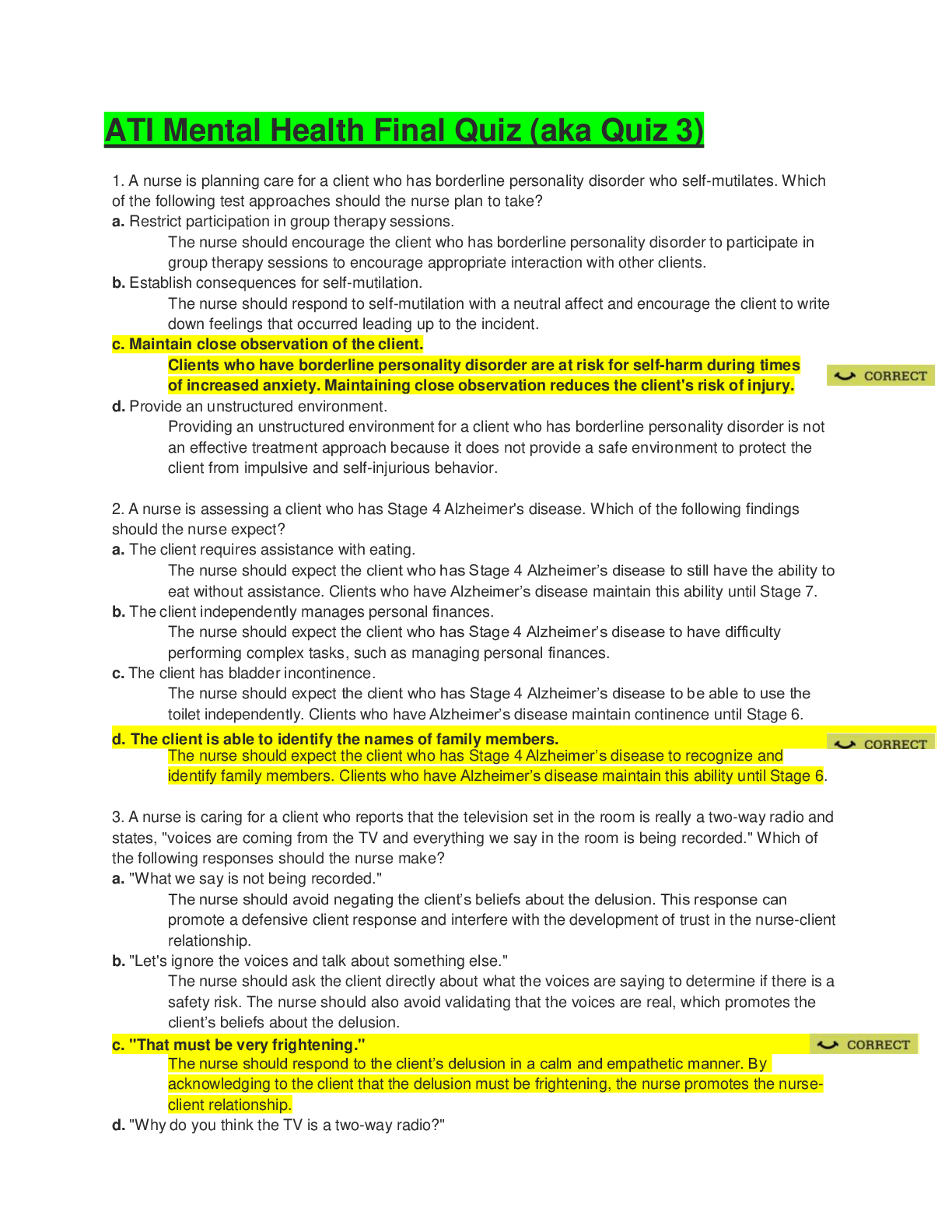
Buy this document to get the full access instantly
Instant Download Access after purchase
Buy NowInstant download
We Accept:

Reviews( 0 )
$14.00
Can't find what you want? Try our AI powered Search
Document information
Connected school, study & course
About the document
Uploaded On
Sep 26, 2021
Number of pages
18
Written in
Additional information
This document has been written for:
Uploaded
Sep 26, 2021
Downloads
0
Views
157









